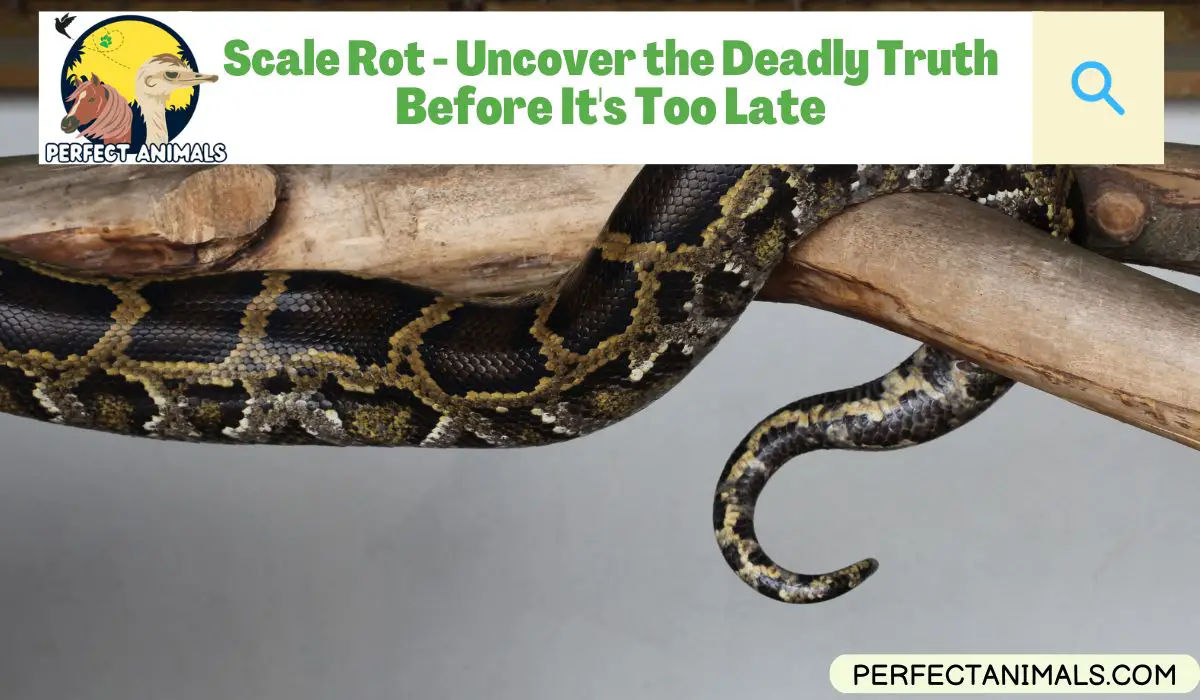Scale rot is a common skin condition that affects many pet snakes.
As a snake owner, it’s important to be able to recognize the signs of scale rot and know how to treat it.
In this article, we’ll discuss what scale rot is, what causes it, how to identify it in your snake, and most importantly, how to treat and heal scale rot.
We’ll also answer some common questions like can a snake survive scale rot and how long it takes for scale rot to heal.
By the end, you’ll have a good understanding of this troublesome skin condition and how to help your snake recover.
So if you suspect your snake may have scale rot or just want to learn more, read on to get the facts.
What Is Scale Rot?
Scale rot is a common skin condition seen in snakes.
It’s a bacterial infection that affects a snake’s protective outer layer of scales.
Scale rot causes the scales to deteriorate, become discolored, and eventually slough off.
This leaves patches of dead, damaged scales that ooze fluid and expose the sensitive inner skin.
The condition gets its name from the scales that literally begin to rot away due to the bacterial infection taking hold.
The scales become swollen, necrotic (dead) and ulcerated in appearance.
Fluid will weep from the underside of the swollen scales.
As scale rot progresses, the tissue under the damaged scales can become inflamed and infected as well.
Visible symptoms include sunken, discolored scales that may have a cheesy white substance on them.
The snake’s skin around the infected areas may also turn various shades of red, pink or orange.
Related Article – Bearded Dragon Tail Rot
What Causes Scale Rot in Snakes
The primary cause of scale rot is a bacterial infection.
There are a few different bacteria that can be responsible, but common culprits are Pseudomonas, Proteus, and Aeromonas species.
These opportunistic bacteria are normally present in small amounts on healthy reptile skin.
However, they can proliferate and cause infection if conditions allow.
There are several factors that enable these bacteria to overgrow and penetrate beneath the scales, leading to scale rot.
- Unsanitary enclosures – Buildup of waste, dirt, and shed skin creates an ideal environment for bacteria to thrive.
- High humidity – Constant dampness weakens scales and skin, making them more permeable to bacteria.
- Poor nutrition – Malnourishment and vitamin deficiencies lower immune response, increasing susceptibility.
- Injury – Cuts, abrasions or damage to the scales from sharp objects can provide an entry point for bacteria.
- Stress – Issues like improper temperatures, handling distress, and other stressors may compromise the immune system.
- Underlying illness – Existing conditions like infections or mites can leave the skin and scales vulnerable to secondary bacterial invasion.
Related Article – Bearded Dragon Shedding
How to Identify Scale Rot
Recognizing the signs of scale rot early is important for getting treatment started quickly.
Here are the main symptoms to look for.
- Changes in scale appearance – Scales may appear swollen, sunken, discolored, or wrinkled. Often the belly or underside scales show changes first.
- White cheesy deposits – These creamy or yellowish deposits on the scales are fluid and dead skin cells from bacterial infection.
- Reddened skin – The skin surrounding infected scales may turn various shades of red, pink or orange as inflammation sets in.
- Odor – There may be a distinct, pungent odor coming from infected areas due to tissue necrosis and bacterial colonization.
- Increased shedding – The snake may shed its skin more frequently as the body tries to rid itself of necrotic tissue.
- Loss of scales – In advanced cases, scales begin sloughing off completely, exposing raw, ulcerated skin.
- Appetite loss – Lethargy, weakness and appetite loss can signal advanced scale rot, as the snake now battles sepsis.
How to Treat Scale Rot
Treating scale rot requires cleaning the infected area, fighting the bacterial infection, and supporting healing.
Here are the main treatment methods.
Antiseptic Cleaning
- Gently scrub affected scales daily with a soft brush and diluted antiseptic solution like Betadine or chlorhexidine. This helps remove debris and discharge.
- Rinse cleaned areas with plain water afterwards. Pat dry if possible.
- Take care not to scrub too hard and cause further injury or scale loss.
Antibacterial Medication
- Apply antibiotic ointment like silver sulfadiazine to infected areas daily after cleaning.
- Oral or injectable antibiotics from a vet may be needed for advanced infections. These treat systemic illness.
- Continue medication for 2-4 weeks after visible signs have resolved to prevent recurrence.
Improve Husbandry
- Ensure enclosure is spotlessly clean and dry. Disinfect and change substrates frequently.
- Maintain proper ambient temperatures and humidity range.
- Quarantine snake from other reptiles during treatment.
Supportive Care
- Apply vitamin A & D ointment to encourage healing after antibiotic ointments.
- Provide optimal nutrition and hydration.
- Limit handling to reduce stress and allow snake to rest.
With diligent cleaning and antibiotics, scale rot often resolves within a few weeks. Seek veterinary care if it advances or fails to improve.
Recurrence is common if underlying factors aren’t corrected. Patience and commitment to care are key for recovery.
You May Also Like – Albino Ball Python
Can Scale Rot Kill A Snake?
Scale rot can lead to serious, even fatal, outcomes for snakes if the bacterial infection is allowed to advance unchecked.
In mild cases caught early, targeted treatment of the affected skin may be sufficient to resolve the problem before it progresses deeper.
However, scale rot has the potential to turn into a much more dangerous infection.
As the skin infection worsens, bacteria can spread into the snake’s bloodstream and penetrates internal tissues and organs.
The sepsis resulting from this widespread infection is what makes scale rot potentially deadly.
The bacteria release toxins that damage tissues and disrupt normal organ function.
Unchecked, the sepsis can lead to multi-system organ failure.
Additionally, large dead patches of skin compromise the snake’s protective barrier. This allows further invasion of bacteria which releases more cell-damaging toxins.
The snake may develop large open wounds that continue to weep fluid, resulting in dehydration on top of everything else.
So, while not always fatal if treated promptly, scale rot can definitely kill snakes when it advances to cause widespread sepsis, abscesses, and dehydration.
Only aggressive treatment at this stage can hope to save the snake’s life.
That’s why early intervention is so important, before the infection reaches this crisis point.
With close monitoring and treatment, even most advanced cases of scale rot can be successfully managed.
Will Scale Rot Go Away With Shed?
Shedding, or ecdysis, is a natural process for snakes to renew their outer layer of skin.
It is tempting to think that shedding the diseased scales will allow snakes to simply be rid of scale rot.
Unfortunately, this is not the case – scale rot will not typically resolve on its own with a shed.
While shedding does remove the visibly affected scales, it does not eliminate the underlying bacterial infection that causes scale rot in the first place.
The infection is embedded beneath the outer scale layer, within the skin.
Shedding alone only removes the dead surface scales, not the deeper infected tissue.
Additionally, scale rot often inhibits a full, clean shed. The sections of stuck shed further irritate the lesions and provide more area for infection to take hold.
Any remaining necrotic tissue continues to decompose and harbor bacteria.
So while an impending shed may make the snake look unsightly, do not delay treatment.
Appropriate medical care is required to address the root causes.
Shedding can aid healing later on by removing the damaged outer layers, but it cannot independently eliminate scale rot.
You May Also Like – Turtles Without Shells
Final Thoughts
Scale rot is an unpleasant but common skin condition seen in pet snakes.
While its appearance is disturbing, scale rot does not have to be a death sentence with appropriate care.
Recognizing early signs like swollen and discolored scales allows treatment to start before the infection advances too far.
With diligence and patience, scale rot can often be resolved and healed.
Be vigilant about monitoring your snake’s skin, especially belly scales prone to this condition.
Preventative steps like spotless enclosures, wise feeding regimens, and prompt treatment of any injuries or minor infections can keep scale rot at bay.
Work closely with an exotics vet if antibiotics or other therapies are needed.
While scale rot treatment takes time, the reward is your snake’s renewed health.
With clean environments, nutritional support, and responsible medical care, snakes can recover fully from scale rot.
Your beloved pet snake can go on to live a long and comfortable life once again.
Stay focused on healing, and be patient – you can beat scale rot together.
FAQs
How do snakes get scale rot?
Scale rot is caused by bacterial infections, often from Pseudomonas or Aeromonas species. Bacteria penetrate scales when skin defenses are lowered by poor husbandry, injury, stress, or other illnesses.
Can a snake survive scale rot?
Yes, most snakes survive scale rot if treated properly with topical disinfecting, antibiotics, improved housing conditions, and supportive care.
However, untreated advanced infections can be fatal.
How long does it take for scale rot to heal?
With appropriate treatment, mild scale rot may resolve in 2-4 weeks. More extensive infections can take 4-8 weeks to fully heal.
Recovery time depends on the severity, how quickly treatment was started, underlying health, and response to medications.
Resources – (for further reading)
MSD Veterinary Manual – Ulcerative dermatitis (scale rot, necrotic dermatitis), ball python
Centers for Disease Control and Prevention (.gov) – Pseudomonas aeruginosa Infection

Hannah owns a collection of reptiles, from geckos to snakes, and her home is essentially a living terrarium. Her expertise and passion for reptiles translate into engaging articles that educate and inspire fellow reptile lovers.

